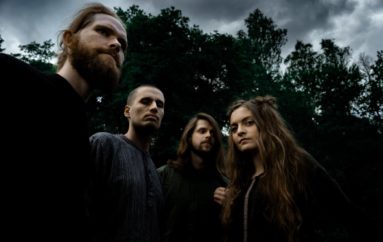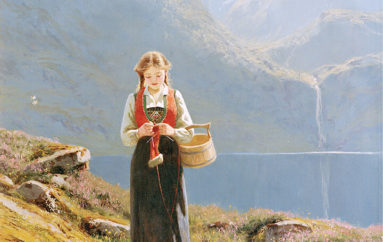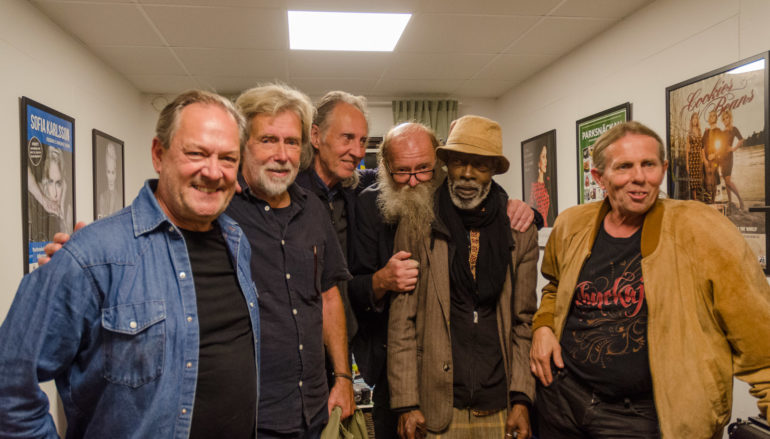
Kebnekajse: At the Foot of a High Mountain
The legendary Swedish folk/blues/jazz rock band Kebnekajse has a long history. The band leader Kenny Håkanson has been onstage since 1963; he and the drummer Pelle Ekmand played together in pop band T-Bones in the mid 60’s. In 1967 Kenny and Pelle were the founders of hard/psychedelic band Baby Grandmothers, after that they joined famous psychedelic rock formation Mecki Mark Men. In 1971 Kebnekaise band was born. To emphasize the connection with native culture and nature, the group took the name in honor of the highest mountain in Sweden. Current name was adopted (to be easier recognizable) in 1977 with “j” instead of “i”.
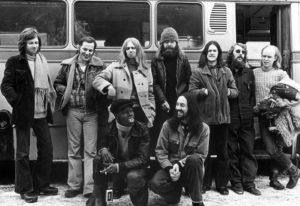 Their debut album «Resa mot okänt mål» (1971) was some kind of hard psychedelic blues; but the best known are, perhaps, their experiments with Swedish folklore – «Kebnekaise II» (1973) and «Kebnekaise III» (1975). The biggest and loudest lineup of Kebnekajse was formed in 1972, with merge-up with the band Homo Sapiens, befriended by the jams in Fregatten club in Stockholm. The sound of Kenny Håkanson’s guitar is very distinctive – there is something very northern, restrained and at the same time reaching the depth of soul. Another recognizable element of sound is Mats Glenngård’s violin. Their excursions into African music, jazz and fusion were also very interesting, but in 1978 the band decided to take a break, which lasted until… early 2000s. Since that time the band is onstage again; they have recorded several new albums till now. The band is very active live and plays many concerts.
Their debut album «Resa mot okänt mål» (1971) was some kind of hard psychedelic blues; but the best known are, perhaps, their experiments with Swedish folklore – «Kebnekaise II» (1973) and «Kebnekaise III» (1975). The biggest and loudest lineup of Kebnekajse was formed in 1972, with merge-up with the band Homo Sapiens, befriended by the jams in Fregatten club in Stockholm. The sound of Kenny Håkanson’s guitar is very distinctive – there is something very northern, restrained and at the same time reaching the depth of soul. Another recognizable element of sound is Mats Glenngård’s violin. Their excursions into African music, jazz and fusion were also very interesting, but in 1978 the band decided to take a break, which lasted until… early 2000s. Since that time the band is onstage again; they have recorded several new albums till now. The band is very active live and plays many concerts.
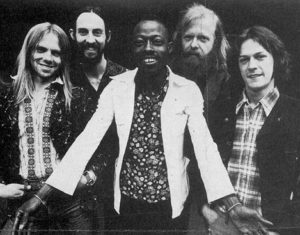 In September 2017 I was lucky to be at Uppsala Prog & Folk Festival in Sweden, where Kebnekajse played a great gig. After the impressive show we had a talk altogether – with lead guitarist and singer Kenny Håkanson, violinist and guitarist Mats Glenngård, bassists Göran Lagerberg and Thomas Netzler, drummer Pelle Ekman and percussionist Hassan Bah.
In September 2017 I was lucky to be at Uppsala Prog & Folk Festival in Sweden, where Kebnekajse played a great gig. After the impressive show we had a talk altogether – with lead guitarist and singer Kenny Håkanson, violinist and guitarist Mats Glenngård, bassists Göran Lagerberg and Thomas Netzler, drummer Pelle Ekman and percussionist Hassan Bah.
Thank you for a beautiful concert! It was one of my dreams to hear you live. The band have been on stage about forty five years already…
Kenny: Yes, me personally started in 1963, and this band is from 1971.
And what gives you energy to be on stage for such a long time?
— It’s fun to play!
— We love music!
— We are old friends!
— We are like a family!
Mats: We don’t know what else we should do! (Laughs.)
 You are travelling a lot now, playing many concerts…
You are travelling a lot now, playing many concerts…
Kenny: Yes, yesterday we played in Gotland.
That’s fine that the band is so active.
Kenny: And we are so young!
Let me ask you some historical questions. You were a part of Swedish progg movement, how did you join it?
Göran: It happened in the end of the 60’s. It was one big festival in the place near Stockholm called Gärdet, and there was lot of bands that played for the first time. That was a start of a movement all around Sweden. Some progressive recording companies also participated in that trip. Kebnekajse signed a recording company called Silence, they had some other progg artists too.
Kenny: And we didn’t call it progg actually. It’s been more journalists called it progg.
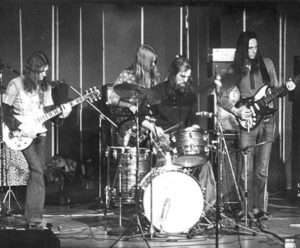 How did you call it?
How did you call it?
Kenny: Just folk music. When we started to play it was folk music. And we didn’t get it from the start, we discovered that movement just after one year.
Did all that bands in progg movement play folk music?
Mats: No. The progg movement was in one way politically oriented. They were singing texts-like songs… as a protest against society mostly. But we didn’t feel we have to do that.
… But against what did you protest?
Mats: We didn’t protest against nothing (laughs), but lot of people protested… against the society, the commercial music…
Göran: It was ugly to be commercial in the seventies!
Kenny: And when you are young, you protest against everything! (Laughs.)
Sweden always was (and is now) a very peaceful country, so you didn’t have reasons for antiwar protests…
Pelle: But we protested against American war in Vietnam!
Thomas: Many people of that time in Sweden felt that the Swedish government was being too much in American hands.
Göran: So it was a lot of thing to protest against, you know! Not only protest, but it was pleased to be engaged in what was happening.
 But the first Kebnekajse album «Resa mot okänt mål» wasn’t folkish.
But the first Kebnekajse album «Resa mot okänt mål» wasn’t folkish.
Kenny: No, it was more like hard rock and psychedelic.
And in that album there was a song named «Kommunisera!» What does it mean?
Pelle: Communicate!
Not to be communistic?
Pelle: No, no! It’s about how to reach each other.
Then you turned your way on the second and third albums, when you have heard the playing of famous Swedish violinists…
Kenny: I worked with Cornelis Vrejsvik (famous Swedish folk/bard singer), when I heard these two guys (Pers-Hans Olsson and Björn Ståbi). Then I discovered that there is something special in folk music. Not only Swedish, but also English, American… That time it started to come from other countries, from Balkan and Africa, I can’t remember if I heard too much about Russia and it was India also…
Mats: We had a group in Sweden that was very famous in the seventies called Södra Bergers Balalaikor! It was about fifty people played balalaikas, including a huge bass balalaika! They were really popular. So it was a world music movement everywhere that’s why we also accepted the Swedish folk music.
Pelle: Some people started to play sitar, Indian music…
Kenny: But we were actually taking care about our roots, so we played Swedish folk.
And what was your aim: to preserve folk music, or to present it to the young generation with a new language?
Mats: Nowadays it’s very important for us to show Swedish folk music in a different way so that young people do not forget their origin.
Kenny: For every new generation. It’s so easy to be seduced by the American and English lifestyle and also music.
 How can you describe Swedish folk?
How can you describe Swedish folk?
Mats: Oh wow! Lot of the Swedish folk music is from dance, dancing. There are different kinds of dances. It could be polska, waltz, polka…
Kenny: It is always three beat.
Mats: And this music used for weddings or for other occasions, when it’s some party… and even in funerals!
Kenny: Long time ago there were many people who have fiddles (folk violin) to play on. And women who grazed cows sang with special voices. So they had even a language they could call each other because that singing you can hear for miles in the forest. So they could talk to each other.
You’ve mentioned polska, what is it?
Kenny: it’s a three beat dance and different parts have different accents like this (singing).
Mats: It’s like dancing in the round.
Did polska come from Poland?
Mats: We don’t know actually.
Kenny: Maybe the word came from there. They had a dance in 1700’s called polonaise. Mostly in high society, among the rich people.
And where have you been taking these melodies?
Mats: Oh, You have to search among old folk notes, you have to listen old tapes… it’s a lot of job! To find a song.
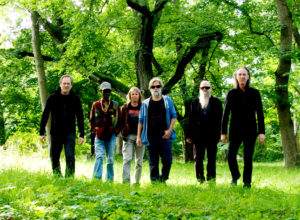 So when you listen to the song you have to write notes.
So when you listen to the song you have to write notes.
Kenny: No, we can find tunes already written. In a big filing system.
Mats: Yes, there are lots of songs!
Pelle: One Swedish guy in the forties had a tape recorder and he went around in the country side and recorded all these violin players. He didn’t even have to write music, he played by ears, he learned these songs from another guys. So most of these songs are called after someone.
Mats: You know it’s thousand and thousand of songs that written down. And to find songs that suit us is a big work. You really have to search and play through maybe hundred of sheets before you find out that one.
And how do you realize it?
Kenny: The song must be possible to play on the guitar and have a clear and steady beat. There must be some potential for developing the song…
Göran: It’s like blues songs, thousand of blues songs…
Mats: I think we’re searching for a melody that everyone remember and thath you can sing. It must be clear.
How do you arrange songs?
Thomas: We sit down – learn the notes and play it several times during time until we find out the right feeling.
Mats: We begin with a melody, and then we try to find some beat around it, and texture… it can take time!
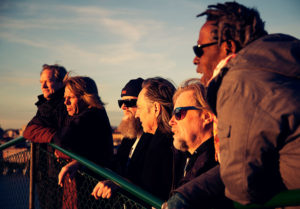 And how do you divide the melody between the violin and the guitar?
And how do you divide the melody between the violin and the guitar?
Kenny: Normally we play the same melody and sometime we do some harmonies (thirds). But very often we play in unison.
Is it a place for improvising?
Mats: Yes. Melody is the base. You always come back to the melody we say. It used to be like maybe one or two parts in the song. We like songs with three parts. It is more to work within.
By the way, what does it mean – song after someone, after Ericsson for example?
Göran: The guy who played the song learned it from someone else. So it’s the name of the guy who wrote it down.
Mats: He wrote it down because he had heard it somewhere. Somebody played it for him.
So it isn’t the name of the composer?
Göran: It might be but more often not. Some songs are so old that we don’t even know who composed them. It can be three hundred years old. You can find it in Finland, in Sweden and maybe even in Russia!
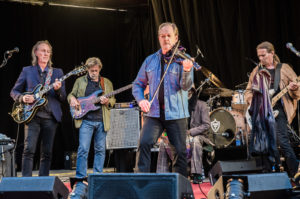 For example, Eklunda polskan is from Eklunda?
For example, Eklunda polskan is from Eklunda?
Mats: Yes, exactly!
Kenny: That guy who made that one as we know is Viksta-Lasse – Lasse from Viksta. (Johan Leonard Larsson (November 4, 1897 − June 7, 1983), better known as Viksta-Lasse, a Swedish fiddler from Eklunda in Uppland, — Wiki). To be able to play the song he tied the upper part of the arm to the body. Because it’s a very fast song!
You have a song called “Spelman” on your last album, and it is a very sad song as I can understand…
Kenny: It’s a poem written by Dan Andersson (famous Swedish poet from the 1800’s), who was living amongst spelmen (spelman was a professional folk musician in Sweden, – fiddler, clarinetist and so on – who played on rural fests earning money by his playing, – E.S.). He says: “I’m a spelman, I play for happy and sad, and I just play for myself because I want to live”. He cannot work with other things because he wants to save his hands. He plays for funerals, he plays for weddings. That what the song says.
Do you feel yourselves modern spelmen?
Oh, yes!
The question about arrangements. You have a very interesting line-up with two bassists and two drummers…
Pelle: We were two bands – Kebnekajse itself and Homo Sapiens, and then we got together in 1972. Two bassists, two drummers, thousands of guitars (laughs). We were ten people then!
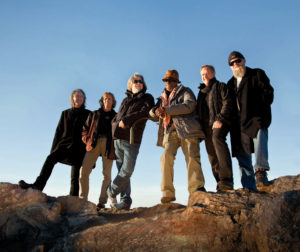 I think you are the only one band in modern music with two bassists.
I think you are the only one band in modern music with two bassists.
Göran: It’s not so common, you’re right!
And how do you decide what to play, how do you divide parts?
Göran: Sometimes we talk about that but mostly nowadays it works like… we try not to interfere too much in each other registers. I play something up here, Thomas play down there and the other way round.
Thomas: It’s make a special groove. Really!
Mats: Yes, very heavy special groove. When you just hear the basses and the drums, it’s quite effective!
Effective and exotic! By the way, Hassan, how do you call this drum with something like ears?
Hassan: Djembe!
And what else African instruments do you use?
Hassan: Timbales, tambourine, cowbell, sometimes my mouth! (Laughs.)
 You have an album «Ljus från Afrika» (1976) – are there your songs on it?
You have an album «Ljus från Afrika» (1976) – are there your songs on it?
Hassan: No, it’s old songs from Guinea.
Are you from Guinea-Bissau, right?
Hassan: No, I’m from Guinea Conakry (Hassan Bah had moved to Sweden in 1969 to have possibility to develop as an artist that he couldn’t do in his homeland, — E.S.). There are Guinea Equatorial, Guinea-Bissau, a lot of Guineas, but Guinea Conakry is the only one.
The first album was heavy, then you have played folk music, then more jazzy staff. And in 1978 the band was split. The question is quite simply: why?
Mats: I think we had been playing together for a long time in the 70’s. There was another kind of life in the late seventies. I think we were a little bit tired…
From each other?
Kenny: Yes, actually. I think we lost our way. We didn’t know what to do. We were stuck about these folk things and wanted to do something else and were inspired by jazz. Again we were too much inspired from the Americans. We were back when we started.
But you didn’t want to protest this time?
Kenny: No, there was too easy to like the American music. Because there is really so much good music from America.
Mats: I think it’s really interesting that the band was playing from 1971 till 1978. And now we’ve been playing from 2001 until now. So we’ve been playing longer now than before!
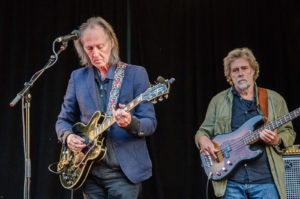 That’s really cool! But what were you doing all that time when the band was split?
That’s really cool! But what were you doing all that time when the band was split?
— Playing with other bands!
— Different things!
— Working!
— Had normal jobs!
Which jobs did you have?
Mats: I was having a break for several years with my kids and family, and I had another job. I was making a newspaper like you.
So you are also a journalist?
Mats: Not a journalist, but doing an artwork.
And you guys?
Göran: I’ve been a musician for many years but I’ve also been working in a computer business for Scandinavian Airlines and here and there.
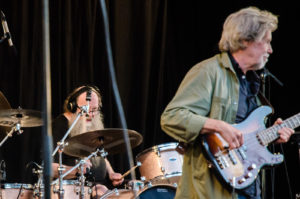 What did you do, Kenny?
What did you do, Kenny?
Kenny: I was playing with other bands also. After 79 I started to play in a group that was quite popular and I stayed there for two years.
What band was it?
Kenny: It was Dag Vag (Swedish pop/punk/reggea band). And after two years I felt tired of those people too (laughs). And I wanted to do something else and I played some blues and boogie in Bills Boogie Band.
And you, Mats?
Mats: I had my own band and made a record during that time. Played with jazz and funky-inspired musicians. Many famous musicians from different contexts. I also worked with graphic design at various advertising agencies.
And then in the 2001 you reunited. How did it happen?
Pelle: The Modern museum in Stockholm was begging and begging us to get together, and we have done it. And we have played there. It was much fun!
Mats: It was very touching. The people really liked to hear us again. I think that started the whole thing.
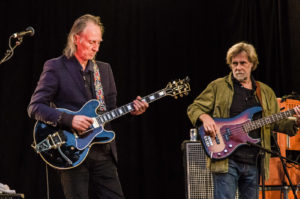 So they invited the band to play for one time, but it was so great that you decided to continue?
So they invited the band to play for one time, but it was so great that you decided to continue?
Mats: Yes.
Kenny: And the news spread out. Other cities and places wanted us to come and play…
Mats: So we were forced to practice again! Because it was new time to practice, make the songs new again.
You have already released three albums since that time. How did the new songs come to you?
Mats: Like always – we tried to find them. We use books with printed folk melodies; it’s like a real bank of folk music.
And what are your plans?
Mats: We are working at the next album. But it takes more time for every record. I think it’s more difficult today.
Kenny: Because we want to be so good as we can’t actually make it (laughs). We don’t want to make a bad album or something that we’ll regret. We’re working on different kind of music, not only folk style, but also something around it. We have 4-5 new songs now…
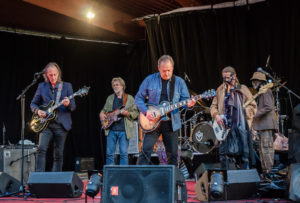 We’ll be waiting! I just want to ask some more questions about your past before saying goodbye. Kenny, in the beginning of 70’s you were playing in some other bands too. Among them, also quite known band Fläsket Brinner.
We’ll be waiting! I just want to ask some more questions about your past before saying goodbye. Kenny, in the beginning of 70’s you were playing in some other bands too. Among them, also quite known band Fläsket Brinner.
Kenny: No, it was Thomas who played with them. I played with Fläsket Brinner maybe just one or two times as a guest.
Can you tell me what does the name mean?
Kenny: Fläsket is pork and brinner is burning. The pork is burning.
Thomas: The pig is on fire! Pork is also slang for money. That was symbolic thing behind it. It’s a way to show you how they despise the capitalists. The men who spend a lot of money. I played with Fläsket Brinner for a couple of years. And they had a poster with a drawing of a man smoking a cigar in the form of a dollar.
Kenny: I didn’t know that!
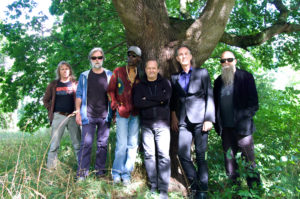 I also would like to know about another hero of progg, a very talented keyboardist Bo Hansson. He has almost disappeared in 80’s. What happened with him?
I also would like to know about another hero of progg, a very talented keyboardist Bo Hansson. He has almost disappeared in 80’s. What happened with him?
Pelle: He was drinking! Every day.
Kenny: Yes, too much heavy drinking. And some other drugs too. So he went that way.
It’s a pity. I like so much his albums after Tolkien and about the Moomins…
Kenny: Yes, they are very nice! He was very natural, because he was not educated. He was finding his own way. And he got too much money too early. And he had to burn it!
Mats: Maybe he was getting bored with all of that.
One more question about the name of the band. You’ve named yourself in honor of the greatest Swedish mountain – Kebnekaise. It’s interesting, have you ever been there?
Mats: Yes we have. But we spell Kebnekajse with ”j” instead of ”i”.
Thomas: But not on the top. We’ve only been on the base, …he.
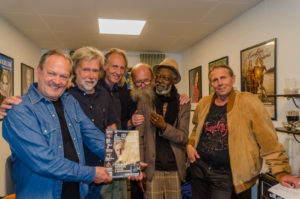 Is it really so high?
Is it really so high?
Mats: It’s not that very high. It’s 2130 meters. In comparison with Alps it’s not so great… But it’s difficult to get up there. Sometimes people can walk up like this… but sometimes they die. Because it can be very cold there.
Did you travel there specially to see the place?
Mats: We’ve been there once in April, there was a lot of snow… It’s so far away, one thousand kilometers from Stockholm.
So thank you so much for the interview, I hope we will have your new album soon…
Pelle: I hope we can come and visit you in Russia.
All: Yes!
Text & some photos — Elena Savitskaya for InRock Music Magazine
Official site: http://www.kebnekajse.se/

